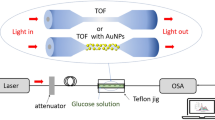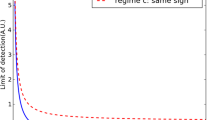Abstract
Interferometric methods are known for their high sensitivity for biochemical optical sensing, but at the expense of their large size. However by using wedge interferometry, the size can be drastically reduced while maintaining adequate detection capabilities. In this work, a miniaturized refractometer based on this interferometer type is experimentally tested to be able to achieve sensitivity of 1.66 × 10−5 RIE/µm and detection limit of 8.7 × 10−5 RIE for bulk refractometry of glucose aqueous solutions. The device consists of two semitransparent mirrors made of glass slides coated by sputtered aluminum thin films, enclosing a tapered frame that maintains one mirror slightly tilted with respect to the other, and simultaneously encloses the liquid under test. Analytical modeling estimation of the sensitivity shows that it can exceed the state of the art for volume refractometry and can be achieved upon using microfabrication techniques. The proposed novel device opens a new avenue for optofluidic detection and is very suitable for point-of-care-testing and handheld devices due to its compact size, simple and cheap fabrication.
Access provided by Autonomous University of Puebla. Download conference paper PDF
Similar content being viewed by others
Keywords
1 Introduction
Optical refractometry is well known for being label-free and real-time method for identifying dielectric materials by measuring their refractive index (RI); thereby, it has various industrial, environmental and biomedical applications. With the wide interest in microfluidics and laboratory-on-a-chip systems, several attempts have been done, trying to integrate various optical detection techniques on-chip [1]. A lot of refractometry methods have the possibility to be easily included into the micro-size system, but most of them still need external bulky expensive equipment such as optical spectrum analyzers or surface-enhanced Raman spectrometers [2]. Using spatial interferometry techniques evades using such bulky equipment, and only a camera is required for imaging; therefore, they are exhibiting a growing interest. Interferometry techniques generally are trusted for their high detection capabilities. The reason behind their high sensitivity is the accumulation of the phase difference along the beam traveling distance of the interferometer arms [3]. But inherently, increasing the arms’ length implies large size apparatus to provide the high sensitivity, which is not suitable for portable devices. This is not necessarily the case with the wedge interferometry configuration introduced in this work. In wedge interferometry, the slope of one mirror with respect to the other also controls this issue, overcoming the large size problem.
In the literature, Young interferometer (YI) configuration holds the record for highest sensitivity for both surface and bulk refractometry. Surface refractometry depends on the evanescent field that passes through the liquid touching the surface of the device. The resolution of these techniques is superior, which are capable of detecting refractive index changes (Δn) as small as 9 × 10−9 RIU in case of YI configuration [3]. For volume refractometry, the sensitivity is generally less, but it is more immune to surface contamination as the light passes through the test liquid itself. A Y-branch on-chip configuration could give sensitivity of 2.5 × 10−7 RIU/µm and Δn of 1 × 10−7 RIU [4]. The size of these devices is usually in the order of decimeters and only available as a benchtop equipment. In this work, a compact size, cheap and simple refractometer based on wedge interferometry is proposed. The modeling of this configuration proves its ability to achieve high sensitivities with much less sizes than accomplished previously. The experimental demonstration of the refractometry performance is also presented.
2 Proposed Structure
The schematic of the proposed structure is shown in Fig. 1a. It consists of a Fabry–Pérot cavity with variable gap thickness, implemented by two mirrors in front of each other with one of them tilted with respect to the other by a designed tilting angle. The tilting is maintained by a fluidic chamber with a variable height made of polydimethylsiloxane (PDMS) polymer. It has a height of (d) from one side and a height of (d + t) from the other side. This frame is sandwiched between two semi-reflecting mirrors. Due to the varying height of the frame, one mirror is tilted by an angle (α) with respect to the other mirror. Input/output fluidic tubes are connected to deliver the liquid under test to the device. When a collimated monochromatic light is incident on this varying length resonator, the cavity length \((\ell )\) at some regions will be equivalent to multiples of λ/2 forming constructive interference and hence a bright fringe at the output due to perfect phase matching between the multiple reflected rays between the two mirrors. The phase difference will change gradually with moving along the mirror tilt until a completely destructive interference occurs producing a dark fringe at the output. The lines of bright-dark will be repeated successively, whose periodicity and width depend on the title angle α. Upon introducing a fluid sample with certain RI (ns) inside the chamber, the optical path length of the resonator will be changed to \((\ell .n_{s} )\), causing shift in the interference fringes’ pattern. The sensitivity can be determined by the formula in Eq. (1).
where S is the slope of the tilted mirror and is related to the tilt angle by the relation S = tan(α). This equation can be used to predict the performance of the sensor with certain design parameters as indicated in Fig. 1b, which plots the sensitivity versus the cavity length for different values of the slope. It is explicit that increasing the cavity length and decreasing the slope achieve higher performance. For example, a slope of 0.001 and a resonator length of 1 cm can theoretically achieve sensitivity of 10−7 RIE/µm, which is better than the state of the art of volume refractometry presented in the introduction, even with much less size. With tolerating longer lengths of few centimeters and smaller slope of 0.0001, beating the state-of-the-art surface refractometer is even possible. But that requires precise dimension control.
3 Experimental
Semi-reflecting mirrors are fabricated by sputtering aluminum thin film on cleaned glass slide covers. The tilted chamber is fabricated by mixing the PDMS gel with its curing agent in a dish that is left for curing on an optical table to ensure flat leveling. The dish is elevated from one side only by putting beneath it a glass slide (thickness ± 0.5 mm) to produce variable thickness PDMS film with certain tilt angle. After curing, the PDMS is cut in square pieces equivalent to the mirror size, and an opening is cut inside to produce a room for the liquid sample. Two fluidic tubes are connected through the frame for sample delivery and disposal. Then finally, the two mirrors are bonded from top and bottom of the PDMS frame. A green laser pointer with a good collimated beam has been used to illuminate the device, and the produced interference patterns are recorded by a CCD camera with pixel pitch of 2.2 µm. The obtained images are analyzed by image processing to extract the interference patterns. Figure 2a shows the normalized intensity of the fringe patterns for DI water and glucose aqueous solutions with concentrations of 0.1 and 0.15%. The evident spatial shift between them corresponds to the change in RI of each solution.
a Interference patterns for DI water and glucose with different concentrations. The inset shows the image of the interference fringes in case of DI water. b Interference fringes’ shifts with changing glucose concentrations on the left-hand side axis (blue colored), and the theoretical refractive index values on the right-hand side axis (red colored)
From the analysis of the patterns in Fig. 2a, the interference fringes’ shifts with changing glucose concentrations have been determined from all the peaks. The mean and standard deviation (σe) of the data are plotted on the left-hand side axis of Fig. 2b. The mean values are represented by the blue circles, and the error bars represent ±σe. Theoretical RI values for the glucose solution of concentration 0.5% are obtained from the literature [5]. The relation between RI and glucose concentration is assumed to be linear within the low concentration range and is plotted on the right-hand side axis in Fig. 2b represented by the red line. The linear plot is used to estimate the sensitivity of the device that is found to be 3.65 × 10−5 RIE/pixel. This value depends on the pixel size of the CCD camera in use, and can be enhanced by using smaller pixel size. To avoid this dependence, the shift per length can be employed which will be 1.66 × 10−5 RIE/µm. The resolution of a sensor is estimated by three times the root-mean-square (rms) value of the noise variations, that is the standard deviation σe. From the error bars in Fig. 2b, the maximum standard deviation is 0.79 pixel, and then the resolution 3σe= 2.37 pixel. The detection limit of a refractometer is the smallest change in RI that can be accurately detected, that is sensitivity multiplied by resolution, which gives 8.7 × 10−5 RIE.
References
Fan X, White IM (2011) Optofluidic microsystems for chemical and biological analysis. Nat Photonics 5:591–597
Liu Q, Huang HJ, Chin LK, Yu YF, Li XC (2008) Label-free detection with micro optical fluidic systems (MOFS): a review. Anal Bioanal Chem 39:2443–2452
Schmitt K, Schirmer B, Hoffmann C, Brandenburg A, Meyrueis P (2007) Interferometric bio-sensor based on planar optical waveguide sensor chips for label-free detection of surface bound bioreactions. Biosens Bioelectron 22:2591–2597
Brandenburg A (1997) Differential refractometry by an integrated-optical Young interferometer. Sens Actuators B 38:266–271
Lide DR (2004) CRC handbook of physics and chemistry. 84th edn. CRC Press
Author information
Authors and Affiliations
Corresponding author
Editor information
Editors and Affiliations
Rights and permissions
Copyright information
© 2021 Springer Nature Singapore Pte Ltd.
About this paper
Cite this paper
Gaber, N. (2021). Miniaturized Refractometer Based on Wedge Interferometry for Handheld Testing Devices. In: Xu, L., Zhou, L. (eds) Proceedings of the 8th International Multidisciplinary Conference on Optofluidics (IMCO 2018). IMCO 2018. Lecture Notes in Electrical Engineering, vol 531. Springer, Singapore. https://doi.org/10.1007/978-981-13-3381-1_10
Download citation
DOI: https://doi.org/10.1007/978-981-13-3381-1_10
Published:
Publisher Name: Springer, Singapore
Print ISBN: 978-981-13-3380-4
Online ISBN: 978-981-13-3381-1
eBook Packages: EngineeringEngineering (R0)






